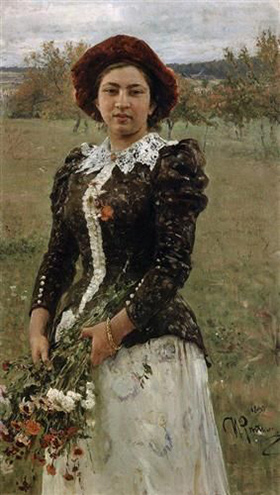Autumn Bouquet is one of the popular paintings of Ilya Yefimovich Repin, the famous 19th-century realist painter from Russia and Ukraine. Repin painted Autumn Bouquet in 1892, around the time when he was at the peak of his powers, painting most of the most spectacular works for which he is renowned.
The original painting, in oil and board, has dimensions of 65 cm x 111 cm, and is displayed in the Tretyakov Gallery, Moscow. Autumn Bouquet depicts a lady holding a bouquet of flows, with the expansive countryside in the background. True to Repin's realism, what strikes most in the painting is the lifelike presentation of a real face, expressing the tragic yet hopeful spirit of the times. The painting is an embodiment of Repin’s artistic gift to gauge the lives and characters of individuals in the society of the times.
As is the case with most of Repin’s work, Autumn Bouquet is an intense reflection of the physical life of the time, with an underlying spiritual connotation. The painting conveys the transient and changeable nature of mind brilliantly. Autumn Bouquet is in tune with Repin’s special ability to capture peasant life in natural surroundings. Repin's underlying themes were consistent with most other Russian realists of the times, who too drew from contemporary life, and tried to depict dramatic conflicts rooted in reality.
Peasants are a popular theme, and almost all artists have at least a few paintings depicting peasants and rural folk. However, no one comes close to depicting peasants in a powerful and vivid way, in natural settings, as Repin does. While Repin was a torch-bearer of realism, with his works the exact reverse of impressionism, he had his own unique and distinctive style. He took his time in completing his works, finalising his sketches after close and detailed study of the topic. Other famous paintings of peasant life include Potato Eaters by Vincent van Gogh, The Stone Breakers by Gustave Courbet and Peasant Wedding by Pieter Bruegel.
Repin's dedication to realism may be gauged by several preliminary sketches before conjuring up his final masterpiece. He is known to change and adjust his methods on a frequent basis, in a quest to seek the perfect arrangement, grouping, and colour. He often painted multiple versions, not being satisfied with what he drew. Ilya Repin's most famous masterpieces include Barge Haulers on the Volga, completed in 1873, and Reply of the Zaporozhian Cossacks, painted between 1880 and 1891, Aleksey Pisemsky, completed in 1880, Modest Mussorgsky, completed in 1881, Religious Procession in Kursk Province, completed in 1883, and other works. Through these and other works, he depicted the spirit of the age brilliantly, and catapulted Russian Art into the mainstream European culture.




